Guide to Britain's basking sharks, including how to identify them, fun facts, where they live and when to see them.
Plus, wildlife photographer, cameraman and presenter Charlie Hamilton James reveals what it’s like to witness the magnificent basking shark up close.
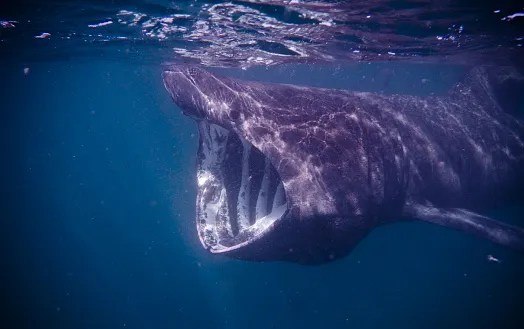
How ignorant are basking sharks?
Measuring up to 12m/39ft (the size of a double-decker bus) and weighing 7 tonnes, the basking shark is the the world’s second largest fish.
What do basking sharks eat?
It feeds on zooplankton, filtering 1,000-2,000 cubic metres of seawater per hour, and occasionally feeding close to shore in large schools of more than 100.
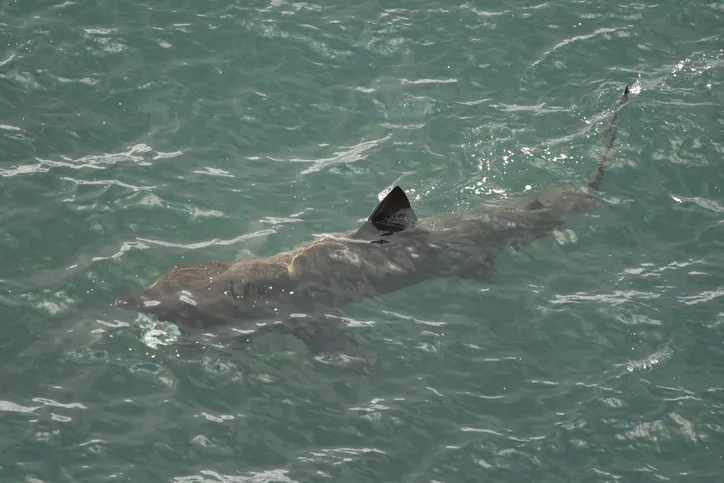
How long do basking sharks live?
Basking sharks can live up to 50 years
When is the best time to see basking sharks?
The best time to see basking sharks is between mid May and July, but you can still find them in British waters as late as October. Wildlife photographer Charles Hood says: “I’ve taken my best images in May (best visibility), have seen the largest shark in mid July (9.5m) and counted the most in one day in September (more than 200).”
Where can you see basking sharks?
Cornwall is one of the best places to see basking sharks, as the water clarity can be 7-20m (23-65ft). The Isle of Man and western Scottish waters are also good. You can also see them off the coast of west Wales and around the Isles of Scilly.
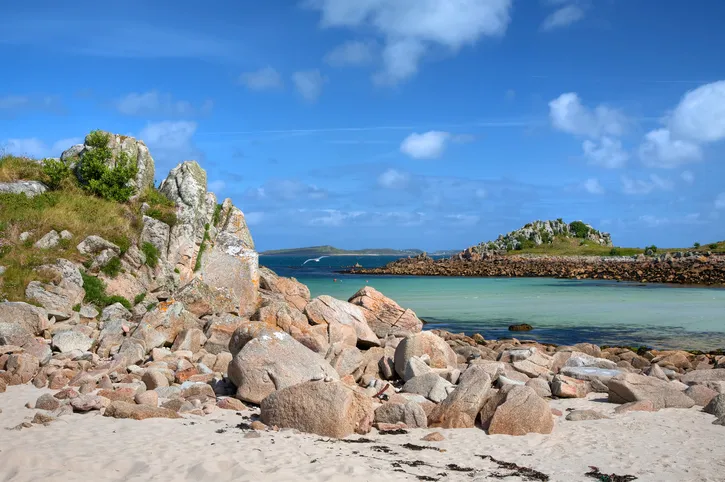
What are the best weather conditions for seeing basking sharks?
A sunny day with calm winds are the ideal conditions for spotting sharks, as the sun brings the plankton to the surface.
- Guide to Britain’s dolphins, porpoise and whales: how to identify and best places to to see
- It weighs the same as two grizzly bears and can be aged like a tree – meet the ocean giant that hurtles through UK waters
It's as heavy as a car, as pale as the moon and looks like a giant dustbin lid – meet one of the ocean's strangest fish
Learn all about Britain's dolphins, porpoise and whales – including identification, the best places to see them and boat excursions – with our guide to the UK's most common cetacean species.
Are basking sharks dangerous?
If you decide to enter the water, the MCS advises: do not touch the sharks, maintain a distance of 4m (13ft), restrict swimmers to groups of four, stay together and avoid flash photography. mcsuk.org
Are basking sharks protected?
Basking sharks are a protected species. It is an offence to cause harm to them. The Marine Conservation Society (MCS) has a strict code of conduct when swimming with basking sharks.
The Basking Shark Project Help monitor basking shark numbers in Cornish waters with the Cornwall Wildlife Trust.
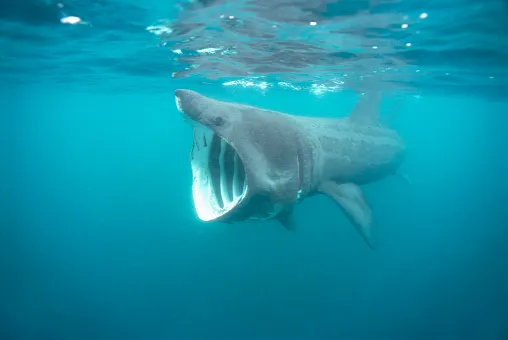
Best boat trips for seeing basking sharks
Charles Hood, Cornwall
Based in Penzance, Charles can arrange shark snorkelling trips for up to seven people on his RIB. First hour £250, then £50 (£75 at weekends) per hour thereafter. 01736 719231
charleshood.com
Marine Discovery Penzance, Cornwall
Wildlife watching boat trips. Adults £35, children £25.
01736 874907
marinediscovery.co.uk
Basking Shark Scotland
07975-72314
Cearban Ltd. 8 McKelvie Road Oban Argyll & Bute PA34 4GB
baskingsharkscotland.co.uk
Hebridean Whale Cruises, Scotland
Pier Road, Gairloch, Scotland, IV21 2BQ
01445 712 458
Manx Basking Shark Watch, Isle of Man
manxbaskingsharkwatch.org/news/boat-trips/
What is it like to swim with basking sharks?
Wildlife photographer, cameraman and presenter Charlie Hamilton James reveals what it’s like to witness the magnificent basking shark up close in Cornish waters.
The last time I was in the water with a massive shark, it was a huge great white and it rammed its head into the cage about a foot from my face. It was exhilarating yet very scary.
Now I face a bigger shark outside a cage and it’s swimming right at me. What’s more, it’s mouth is wide open and, by the size of it, big enough to swallow me whole.
I’ve got the same sense of exhilaration but there’s no fear. I know this gentle giant is only coming to check me out. I calm myself, reduce the breathing through my snorkel and stay stock still. I don’t want to frighten it. The enormous shark swims right up to me until it is two feet away, then veers slightly, passing within inches of me. I turn gently as it drifts past and watch the extraordinary length of it, eventually tapering off to a huge tail, which slowly brushes me. A few seconds later, the shark is lost into the gloom.
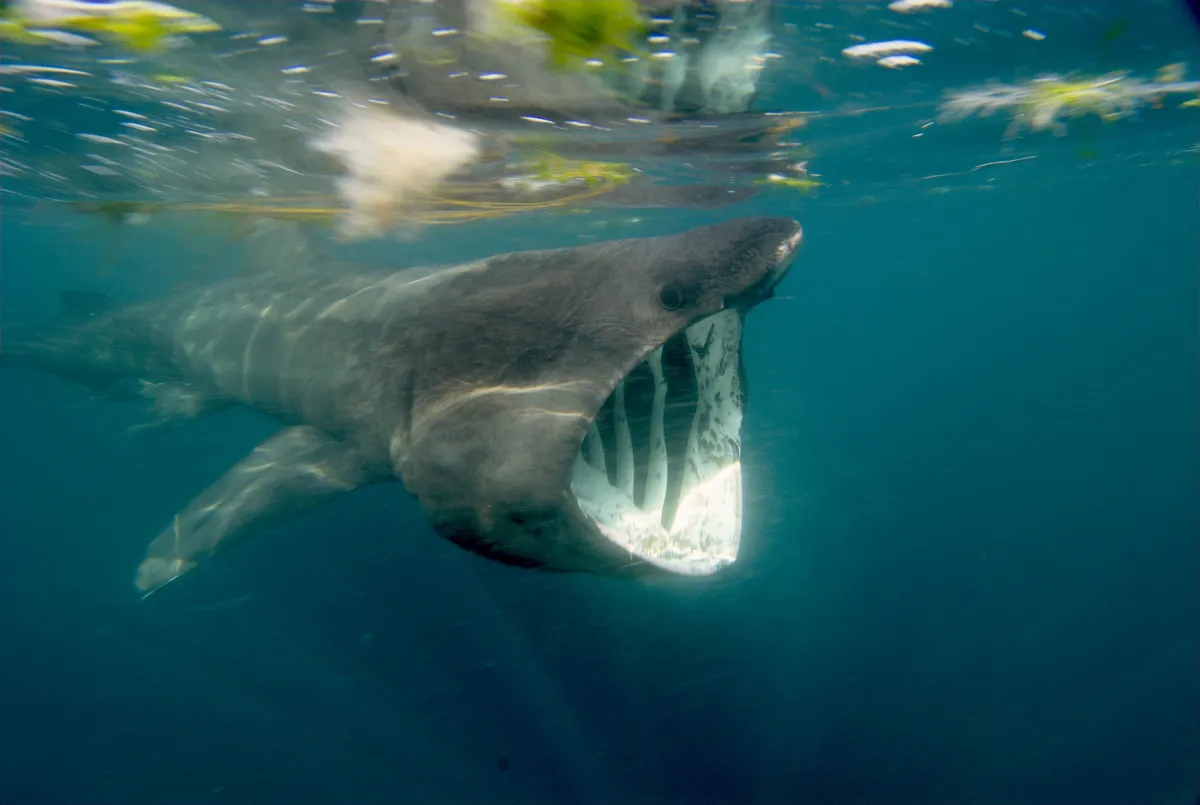
Swimming with sharks
Swimming with basking sharks has always been something I’ve wanted to do. So when the opportunity arose I jumped at it. It was June, and Cornwall was experiencing good numbers of the sharks, which pass nearly every year on their migration north.
I had been invited down for a weekend by a group of divers; they had hired shark expert and photographer Charles Hood to take them as close to the sharks as possible.
We met at the jetty in Penzance and boarded Charles’s rigid-inflatable boat (RIB). It was early and cold and I was slightly nervous, as all the other guys had drysuits on. I don’t own a drysuit, so I wore my wetsuit. The problem with a wetsuit is that when you’re trying to watch basking sharks underwater, you need to spend a lot of time doing nothing. You shouldn’t try and swim up to them, you just need to wait for them to swim up to you. This means getting very cold. Of course at the time, these pros all knew this and I didn’t.
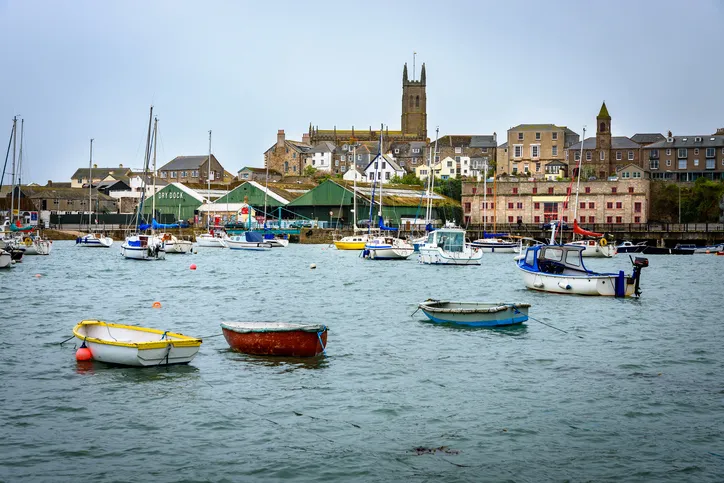
It was a pretty dull, grey start and the wind was up, so as we set off out of Penzance harbour I don’t think any of us believed we were going to be successful. But Charles knew where to take us and we soon found ourselves in calmer water, sheltered from the wind by the land.
It wasn’t long before we saw our first shark, just a large fin slowly cutting through the water. It seemed to be on the move though, and Charles decided that we should not attempt to get in the water with it. He suggested searching for a shark that was feeding in one area. We sped on, sticking close to the cliffs. This remote part of southern Cornwall looks stunning from a boat – lots of high, jagged cliffs and inaccessible beaches that make you forget you’re in Britain.
The weather changed as we travelled; the wind dropped, calming the sea, and the sun came out. After 20 minutes or so, we spotted a shark circling in a single area. Charles said that this would be a good fish to work with.
Three of the gang got themselves ready and jumped in 100m or so from the circling fin. Charles had explained to us the etiquette of approaching a shark, and he reiterated it as the snorkellers got into the water: “Don’t swim at the shark. Stay still, be patient and let it come to you.” We watched from the boat as they moved a little closer. After a while, the shark came into line with them and we watched in awe as it swam right past them – you could hear squeals of excitement through their snorkels.
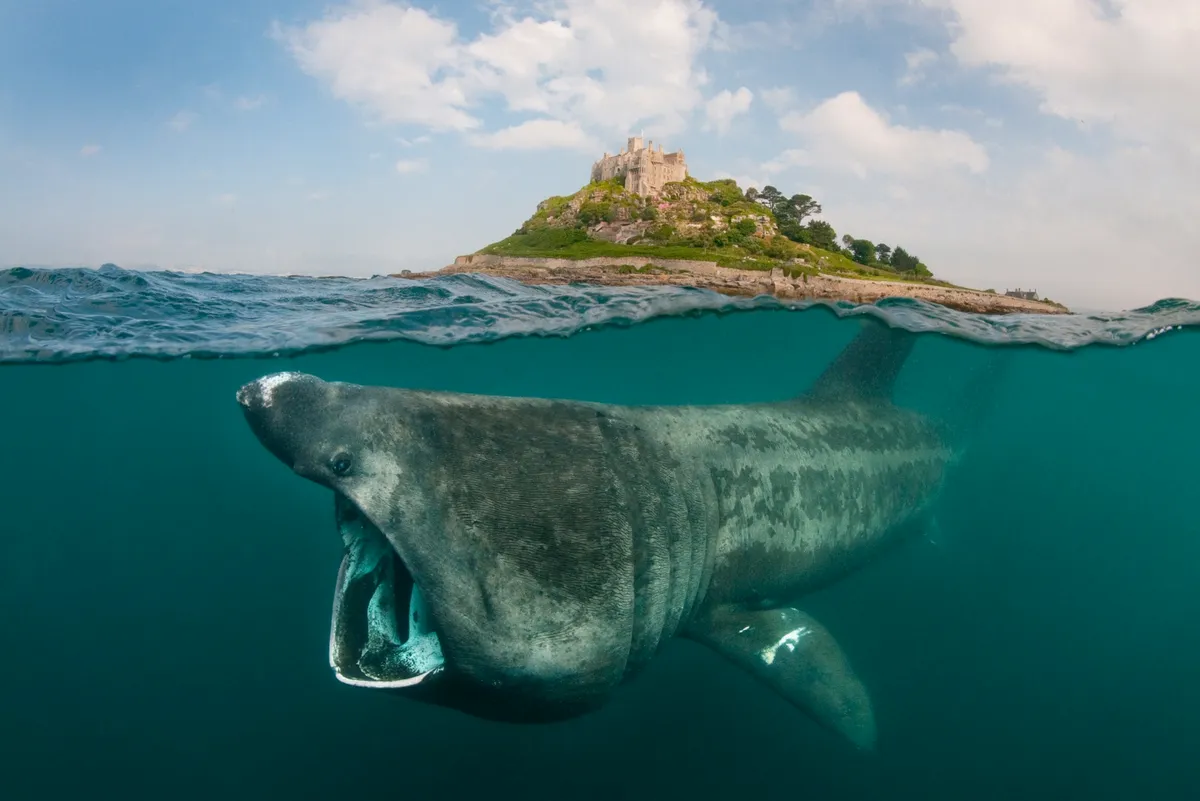
Close encounter
We spotted three more sharks while we waited. They were all very close to the shore, quartering a small area. Charles took us closer and four of us got into the water. We made our way over towards them – not swimming at them, just floating into their general area.
The water was blue, crystal clear and very shallow, only 3m (10ft) or so above a kelp bed. One shark was doing a continuous large circle of the area and was coming towards me. I could see the fin above water 90m (300ft) or so away. As it drew closer I was praying for it to keep its line and not divert – it did.
The first I saw of it underwater was a dark shape moving towards me, then as it got larger and clearer I could see the mouth. It was vast and completely agape. Soon the mouth became the whole shark, I couldn’t see anything else. I froze still in the water and the shark drifted past, eyeing me as it went with its tiny eye. Wow.
I took a few shots as it went on its way and waited where I was for it to come back. We spent a good couple of hours in that one spot. As one shark left, another would arrive. It was incredible. We then moved to another spot and spent the rest of the day with the sharks – they were everywhere. When we finished and headed back to shore, Charles proudly explained to us that in all his years of basking sharking, this was one of the best days.
Main image: Rebecca Belleni Photography, Getty
